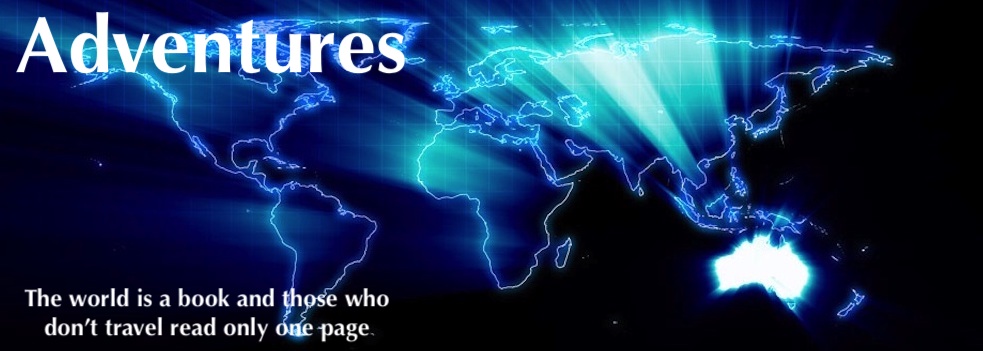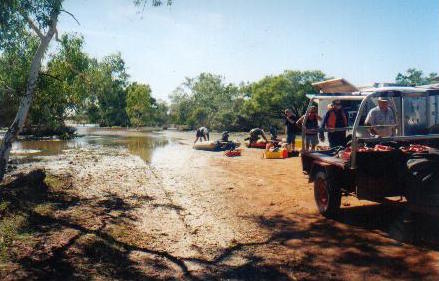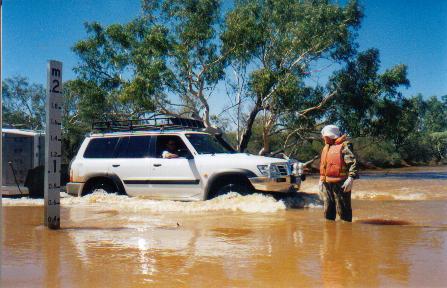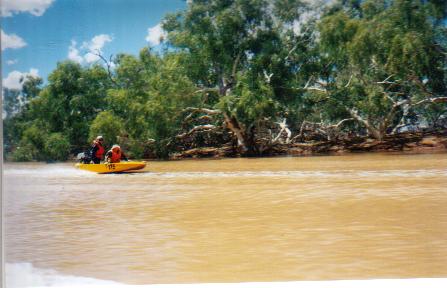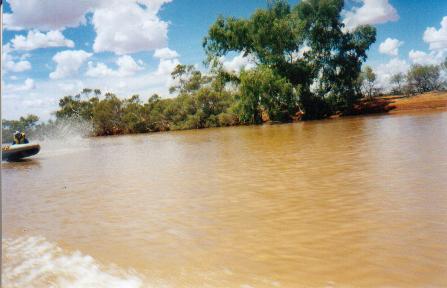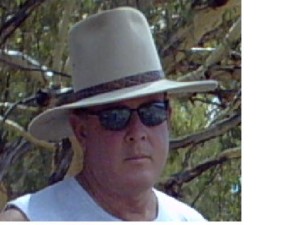The
Murchison River Expedition
March 2004
AT 835 kilometres in length, the Murchison is Western Australia’s second longest river.
The first power dinghy assault on the Murchison was in 1994 (Milly Milly Crossing to the North West Coastal Highway). In retrospect this was an incredible achievement.
Subsequent trips in 1995 and 1997 extended the length of river covered.
This truly remarkable watercourse occasionally presents the opportunity for a truly remarkable boating adventure. Serendipity and happenstance presented just such an opportunity over the long weekend in early March 2004.
Because of the discrete area in which rain had fallen in the upper reaches, this trip could not be extended to the Murchison Gorges to cover the 14 kilometres of the river still un-navigated by power dinghy. However, we knew the country from Milly Milly to the expected finish point at Yallalong to be spectacular, and worth the long drive from Perth.
The word was put out and John and Stephen Bousfield, John Haynes, Kevin Williams (deceased), Cliff Hills, Greg Bardon and I were confirmed starters with Cliff, John and Kevin supplying rigs.
Saturday’s dawn broke as we turned off the Mullewa Road towards Milly Milly Station. By the time we arrived at the crossing, 530 kilometres from the river mouth, there was already some heat in the sun. Preparation of the boats and breakfast took some hours. The temperature quickly rose to 30 degrees Celsius, then 35.
- Preparing to start.
THE FIRST LEG
THIS is very, very remote and potentially dangerous country. Should the Boat Crew experience any difficulties between the planned RV near Manfred and Minnawarra Crossing they were out of reach of the Support Crew. If they failed to reach Minnawarra Crossing the only option would be to mount an aerial search – expensive and embarrassing.
- At the start.
- John guided Kim in the Patrol.
The flow of the Murchison is sweet water over a sandy bottom through avenues of magnificent river red gums. Initially, Cliff had fuel problems and couldn’t get on the plane. Kevin was the only one able to get his rig to top speed.
Fences were a hazard – right across the river at neck height with strain hawsers finger thick. They did little to contain the goats, emus, roos and cattle seen along the way.
- Over the weir.
- Weir
On land, Greg and I followed a track (of sorts) south along the western side of river toward Manfred Station and a pre-arranged rendezvous. Greg navigated and I dodged roos and emus. We called in at a number of spots on the river but decided that the Boat Crews were ahead of us.
One emu bounced off the fence that closely followed the track and then bounced off the Patrol. Semi-comatosed, it staggered off into the scrub.
- Kevin is driving.
Confirmation of the rendezvous was guesswork. The coordinates had been taken from the map (a 1:250,000 topo) and the accuracy that can be determined from such a scale is less than ideal.
We waited 90 minutes at the rendezvous for the Boat Crew. They were trying continually to raise us on the satphone but were unable to establish a connection to the network provider. The satphones were next to useless. It was hot, the flies were bothersome and there was precious little shade. Eventually the satphone rang. After a frustrating conversation with Kevin, I established the locstat of the Boat Crew and then drove 600 metres cross country to the rendezvous. From this point, six kilometres upstream from the Manfred Crossing, it is 60 kilometres downriver to Minnawarra Crossing, the next accessible point (a full day in most power dinghy races). I was very uneasy about leaving the Boat Crew to their fate but there was no alternative.
- Travelling well.
This section of the Murchison River provides some of the most spectacular scenery and wildlife the region has to offer. Swans, ducks and pelicans abound. Magnificent eucalypts line the river to show the course proper as the water spreads across the country. Breakaways, cliffs, sandbars, sweeping bends, tight corners and long reaches provide an ever-changing tableau. John Bousfield described it as:
“a fantastic section of river, which was now getting deeper and more purposeful. Along a section of cliffs we got in the water and just hung on and went with the current. It is the cleanest, best tasting river water I have been in and, on a 40oC+ day, where else would you rather be?”
- Stephen Bousfield
A waypoint for the next checkpoint (Minnawarra Crossing) was set and a protocol for inability to contact by satphone was established and the Boat Crew took off. Greg and I headed of to the next checkpoint – a drive of about 150 kilometres.
Near Curba Station I pulled over for a break. Greg stopped behind and immediately noticed the right tyre on the trailer was flat. Luckily, it had deflated only 40 metres before I stopped.
- Greg Barndon
- Kim Epton
The thermometer in the trailer registered 48oC. The wheel change took 45 minutes – a procedure that, under more favourable conditions, would have taken about 15-20 minutes. As I was sitting on the gravel road with a fierce, biting sun on my back, trying to juggle the wheel onto the wheel studs, I asked Greg, “are we having fun yet?” Such is the attraction of power dinghy expeditions.
Before leaving the Boat Crew near Manfred I made arrangements with Kevin to phone me when the Boat Crew reached Minnawarra Crossing and a decision would be made whether to proceed to Murchison Crossing, depending on condition of rigs, time of day and level of water. So much for the planning! The satphone comms was unreliable and the ‘fallback position’ was for the Boat Crew to remain at the RV.
There remained no option but for Greg and me to drive to Minnawarra Crossing. It was 6pm when we arrived. The Boat Crew had been waiting about two hours.
- At the end of Day One.
Camp was established, dinner cooked, boats repaired, motors checked, props straightened and swags rolled out.
After a long drive the night before with no sleep, a hot and tiring day on the river, and then a few drinks, the entire crew crashed early. It was hot, a very strong north-east wind was blowing and the mozzies were friendly. An uncomfortable night but, if one wanted to experience the thrill and the adventure of a fast flowing Murchison that occurs on average only one in seven years (how lucky have we been? – four trips in 10 years), these privations were a small price to pay.
SECOND LEG
THE next day it was hot even before the push started. Plans were made to rendezvous at Murchison Crossing, 40 kilometres downriver. The flies, heat and humidity made for a slow start to the day. Preparations seemed interminable. Eventually all was ready for a Start.
On the water, the boats set a much faster pace, skating around corners, flitting through trees and frightening mobs of emus.
On water, Kevin relates:
“We were hooting along the river with John and Stephen in front, Cliff in the middle with Greg and me behind, when all of a sudden Cliff stopped dead in the middle of the river. On a closer inspection [we saw that] Cliff had run into a fence under the water. He was catapulted to the front of the boat. He wasn’t injured but it looked funny.”
The Boat Crew headed off to Billabalong Station 67 kilometres downriver. John and I headed to Murchison to refuel. Diesel was $1.25/litre. It was only a short drive (by Murchison standards) to Billabalong Station.
John Bousfield had broken his gearbox only four kilometres after leaving the Murchison Crossing. The Boat Crew had tried to get me on the satphone but there was no network coverage. The satphones were a big disappointment during the whole trip.
A decision was made to tow John’s boat behind Cliff’s because of his bigger motor. Stephen moved into Kevin’s boat with the equipment from the stricken boat, and John went into the front of Cliff’s boat which towed the now powerless inflatable. It was Greg’s job to steer it the best he could and keep it upright. Three times he went to the opposite side of a tree than the towing boat.
- John Bousfield
John described the trip:
“Greg used his weight and mobility to follow us in the towed boat and was entertaining to watch. Trees caused a great problem, as did going sideways and being thrown out.”
- Upper Murchison River.
Greg reckoned that he never had so much fun in his life.
Between Meeberrie and Billabalong the river spreads out into a huge floodplain known as the Wangoolia Floodout.
It was in this vast expanse of water that Kevin and Stephen became separated from the two joined boats. In each of the previous trips (1994 and 1997) that entered into the Floodout, the same drama occurred. It is remote and scary country.
- Kevin Williams
Kevin recalls:
“Within five minutes of re-starting the trip a few problems started to happen. With the extra weight I had in my boat, it took longer to get onto a plane, which meant I was starting to lose contact with the other boats. I lost sight of the boats in front of me. I took a turn down a channel which looked good. After heading down this channel for a short time it didn’t seem right so we backed out and went down another channel where the flow was stronger. We were still uncertain if we were going down the right channel when we started to see bubbles in the water and wash on the banks – certain evidence that boats had passed this way.”
- Typical Murchison country.
Given the uncertainty of the water level from Billabalong to Yallalong – or even to Ballinyoo Bridge – and the u/s gearbox on John’s Mariner, it was a relatively easy decision to pull out at Billabalong. On reflection, we should have continued – at least to Ballinyoo, possibly Yallalong.
THIRD LEG
WE made an early start to Kalbarri and drove straight to the boat ramp in front of the caravan park. The boats were quickly prepared for a dash upriver under threatening skies – the result of a cyclone further to the north.
- John Haynes
- Cliff Hills
The river here is tidal and, at the time we were on it, shallow. I drove Cliff’s duck with John Haynes in the front. Greg and Kevin were in 175. John and Stephen were in their inflatable. Cliff stayed behind and replaced the spare wheel that had been fitted to the trailer on Saturday with the original that had been repaired.
After a few kilometres of shallow water, indistinct channels and hard work it was decided that the goal wasn’t worth the effort and we headed back to the boat ramp, loaded up and headed off to Perth, visiting the spectacular coastal gorges along the way.
CONCLUSION
WE were extremely lucky to have local thunderstorms dump enough water into the river channel at such a convenient time and without adversely affecting roads. We started behind the peak of the ‘fresh’, caught up with it, and had we continued on, we would have run out of water around Yallalong.
The Murchison when flowing is an amazing river. The water is fresh, the country through which it passes is spectacular, the wildlife is incredible, the birdlife is bountiful, the course is challenging and the remoteness is daunting.
And, while we have the capacity to take on the challenges of a remote and ephemeral river, the Murchison will always be at the head of the list.
© Kim Epton 2004-2024
1974 words, 18 photographs.
Text and layout
Kim Epton
Additional material
Kevin Williams
John Bousfield
Greg Barndon
Photographs
Cliff Hills
Kim Epton
Feel free to use any part of this document but please do the right thing and give attribution to adventures.net.au. It will enhance the SEO of your website/blog and Adventures.
See Terms of Use.
